
Charting Iran’s Influence in Africa
Although Tehran’s activities in Africa tend to receive far less attention than its machinations in the Middle East, Europe, or Latin America, they form a critical pillar of the Islamic Republic’s global strategy.

Although Tehran’s activities in Africa tend to receive far less attention than its machinations in the Middle East, Europe, or Latin America, they form a critical pillar of the Islamic Republic’s global strategy.
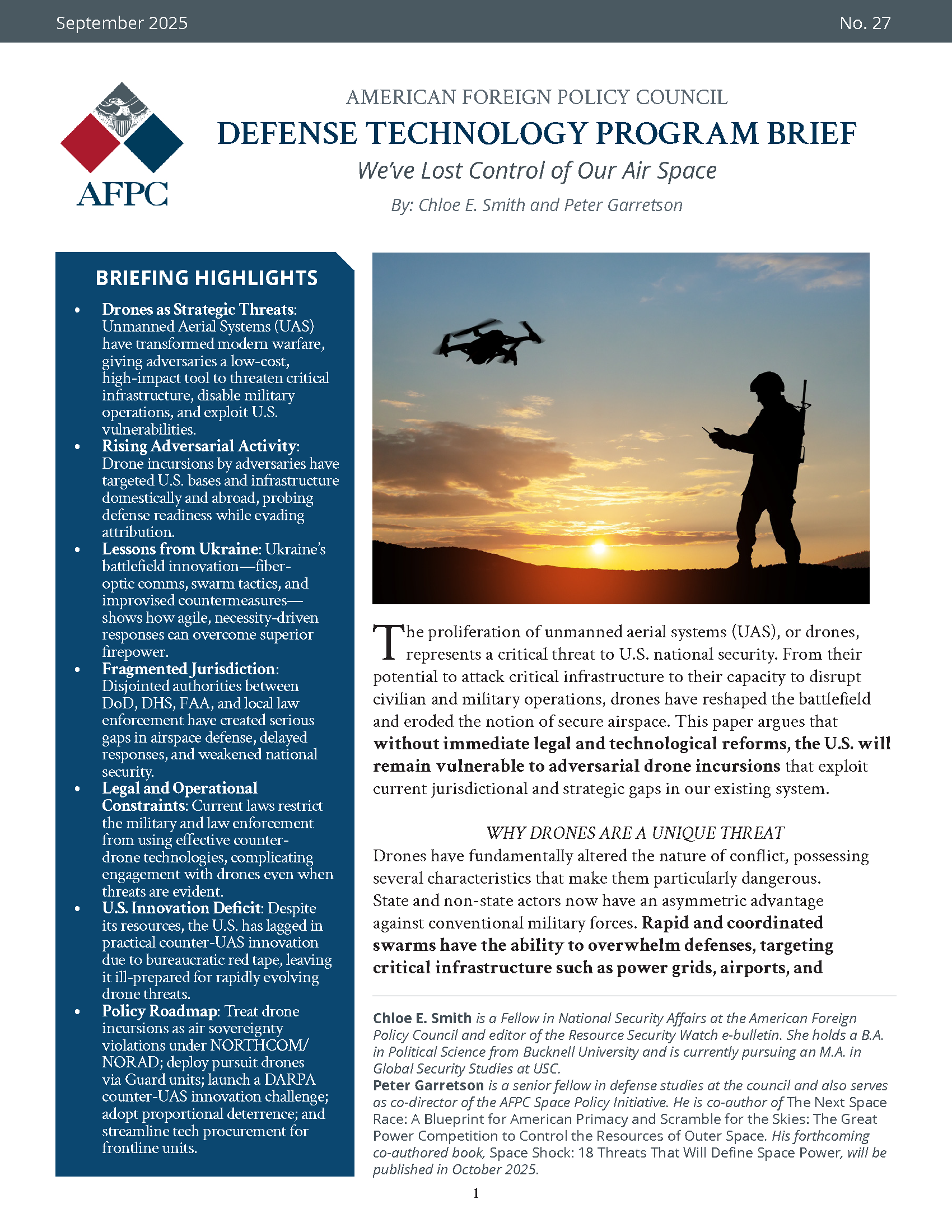
Without immediate legal and technological reforms, the U.S. will remain vulnerable to adversarial drone incursions that exploit current jurisdictional and strategic gaps in our existing system.
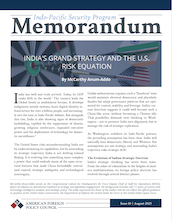
The United States risks misunderstanding India not by underestimating its capabilities, but by misreading its strategic trajectory.
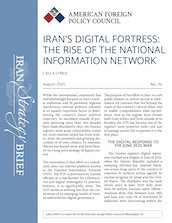
The Iranian regime’s most acute vulnerability comes not from external attack but from within: from the persistent and growing discontent of its own citizens. In response, Tehran has leaned more and more heavily on a long-term strategy of digital control.
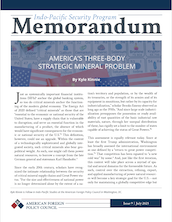
Control over the extraction, refining, export, and applied manufacturing of power natural resources will become a key strategic goal for the U.S.—not only for maintaining a globally competitive edge but also for ensuring Great Power status in an increasingly multipolar world.
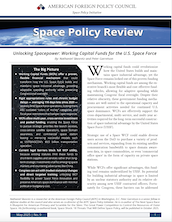
Working capital funds could revolutionize how the United States builds and maintains space industrial advantage, yet the Space Force remains locked out of this proven funding mechanism.
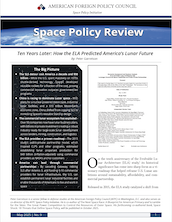
On the tenth anniversary of the Evolvable Lunar Architecture (ELA) study, its historical significance has come into sharp focus as a visionary roadmap that helped reframe U.S. Lunar ambitions around sustainability, affordability, and commercial partnership.
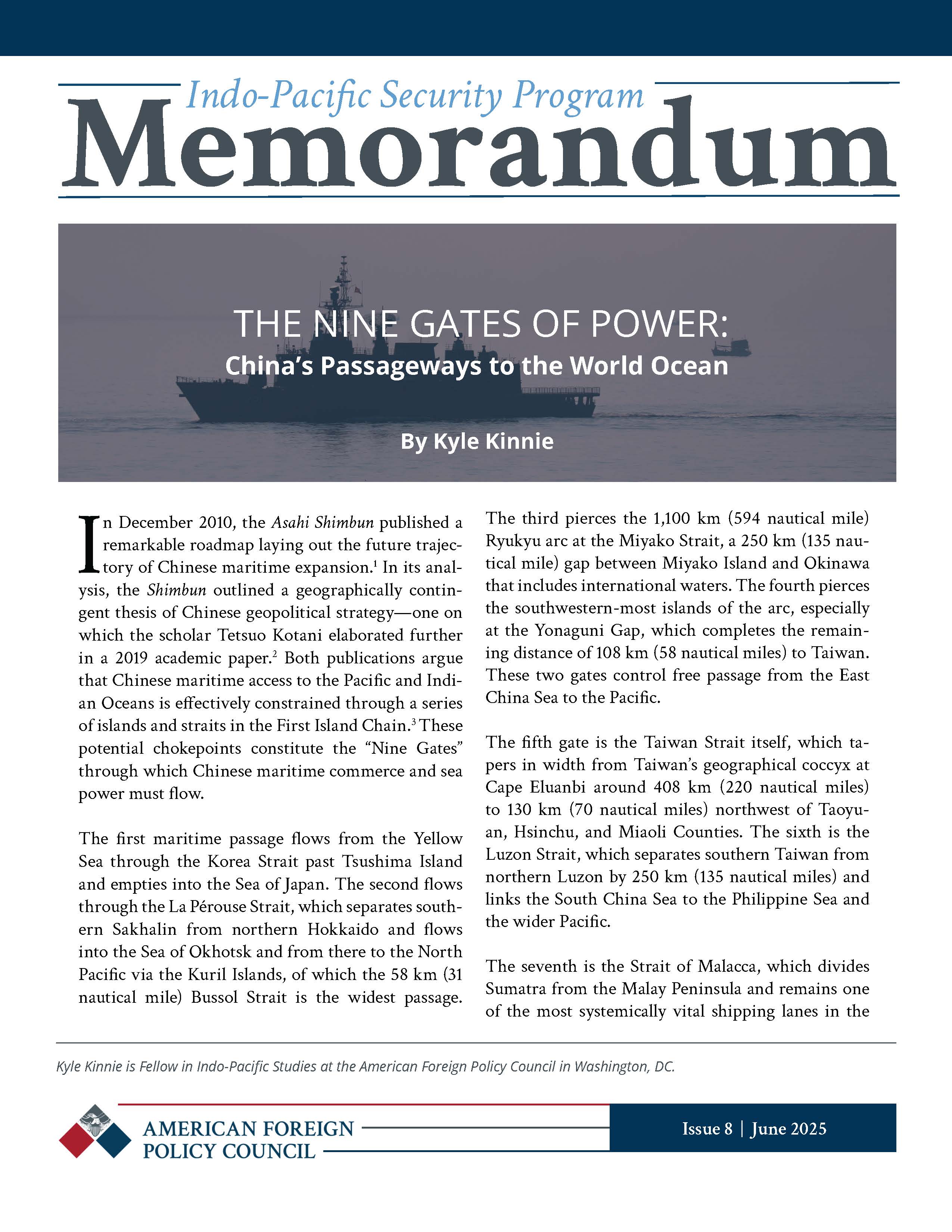
In December 2010, the Asahi Shimbun published a remarkable roadmap laying out the future trajectory of Chinese maritime expansion. In its analysis, the Shimbun outlined a geographically contingent thesis of Chinese geopolitical strategy—one on which the scholar Tetsuo Kotani elaborated further in a 2019 academic paper. Both publications argue that Chinese maritime access to the Pacific and Indian Oceans is effectively constrained through a series of islands and straits in the First Island Chain. These potential chokepoints constitute the “Nine Gates” through which Chinese maritime commerce and sea power must flow.
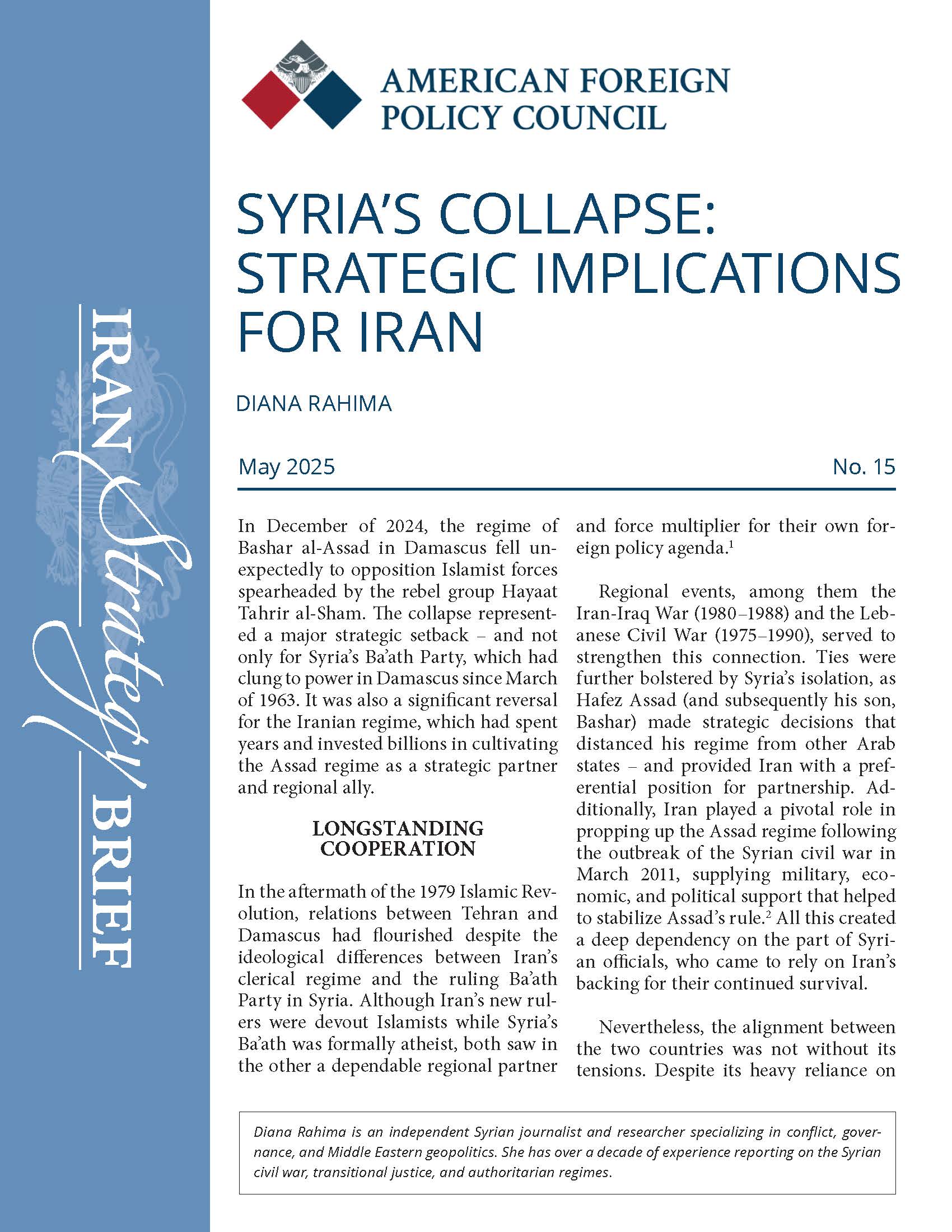
In December of 2024, the regime of Bashar al-Assad in Damascus fell unexpectedly to opposition Islamist forces spearheaded by the rebel group Hayaat Tahrir al-Sham.
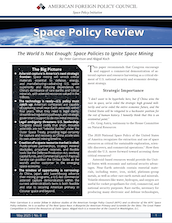
This paper recommends that Congress encourage and support a commercial demonstration of asteroid capture and resource harvesting as a critical element of U.S. national security and economic development strategy.
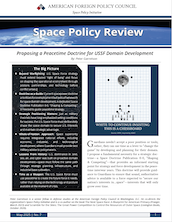
U.S. Space Force strategy must extend beyond “right of bang” and focus on shaping the operational environment through posture, partnerships, and technology before conflict arises.
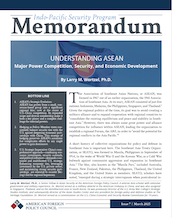
ASEAN has grown from a small, consensus-based group into a significant regional bloc, now at the center of U.S.-China competition. Its expanded scope and diverse membership make it both a key player and a complex challenge for external powers.
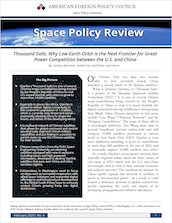
As China rapidly expands its network of satellite mega-constellations, it grows in informational power. As a result, it could acquire a dominant position in global connectivity, greatly expanding the reach and impact of its messaging, propaganda and influence operations.
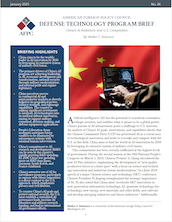
Artificial intelligence (AI) has the potential to transform economies, reshape societies, and redefine what it means to be a global power. China’s pursuit of AI advancement poses a challenge to U.S. interests.
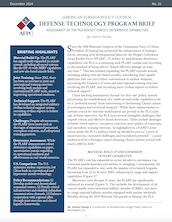
President Xi Jinping has promoted the enhancement of strategic forces, stressing new developmental plans for the People’s Liberation Army Rocket Force (PLARF). The U.S. maintains nuclear superiority, but China leads in conventional and hypersonic missile technology.
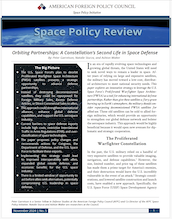
The U.S. Space Force’s plan to deorbit Proliferated Warfighter Space Architecture (PWSA) satellites presents a strategic opportunity to advance defense partnerships.
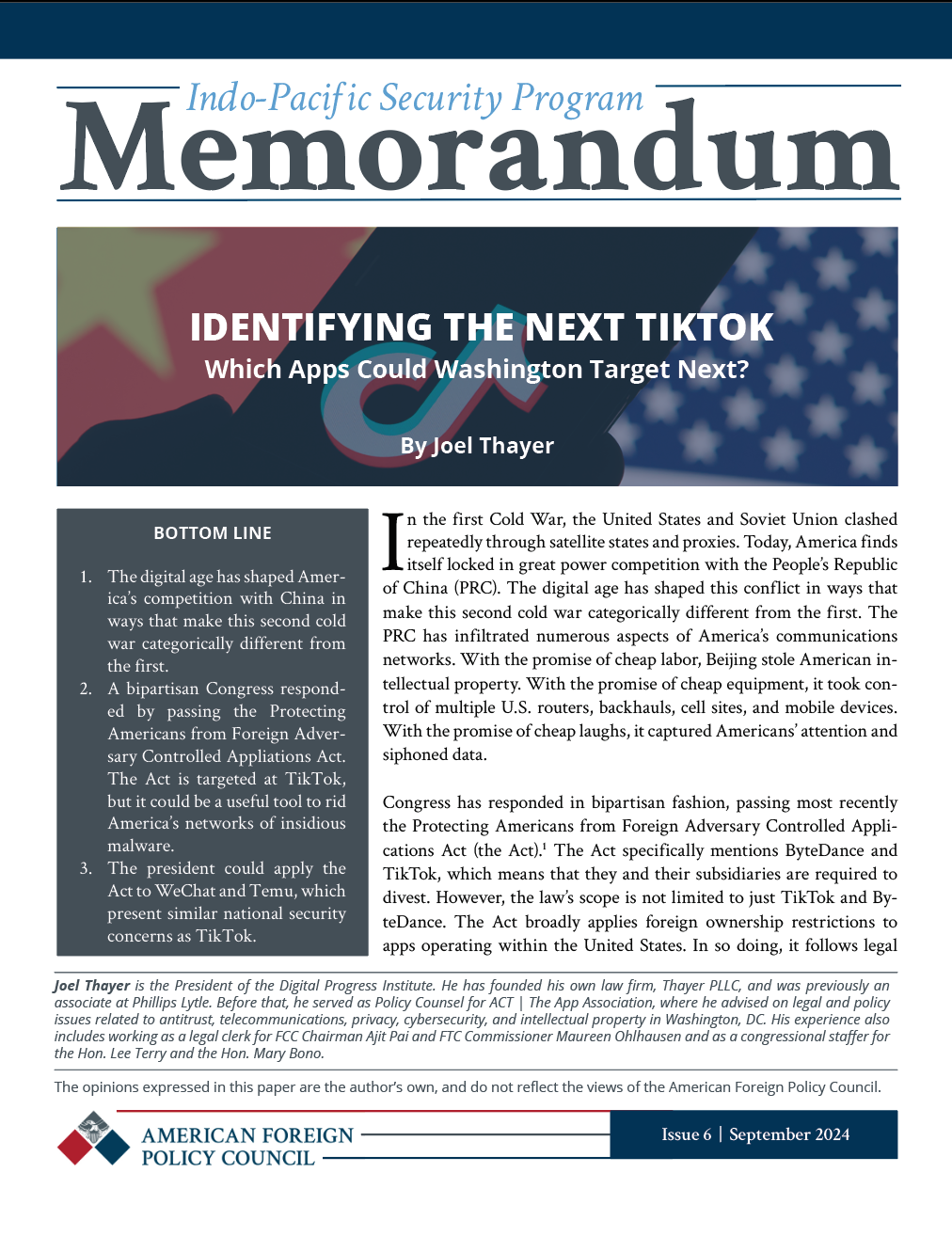
Congress passed the Protecting Americans from Foreign Adversary Controlled Applications Act (the Act). The Act specifically mentions ByteDance and TikTok, which means that they and their subsidiaries are required to divest. However, the law's scope is not limited to just TikTok and ByteDance. The Act broadly applies foreign ownership restrictions to apps operating within the United States. Specific attention is given in this paper to WeChat and Temu.
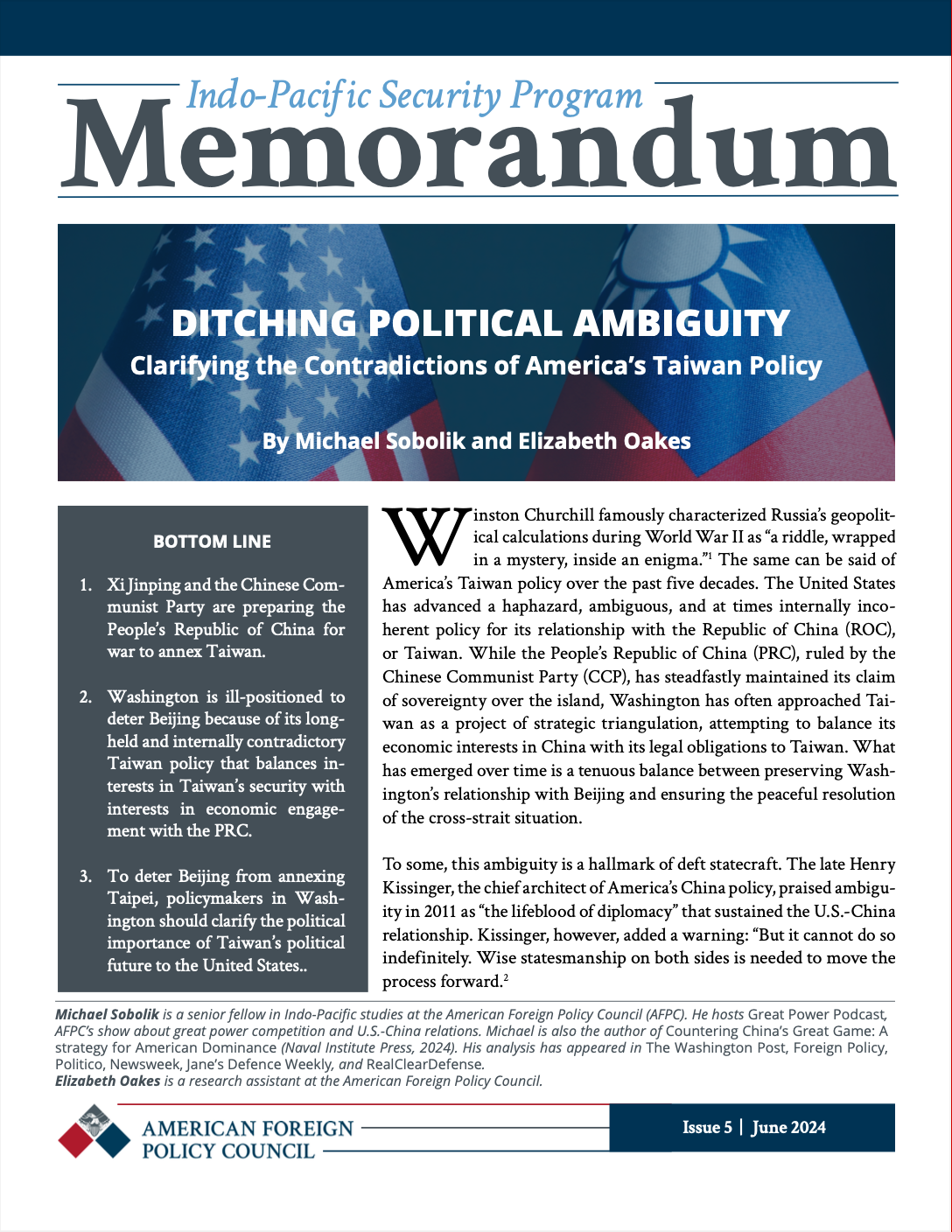
The United States may be running out of time to deter Beijing from subsuming Taiwan. The sooner U.S. policymakers recognize this danger, the better chance America has of forestalling Beijing’s aggression. Doing so will require Washington to clarify the importance of its political relationship with Taipei.
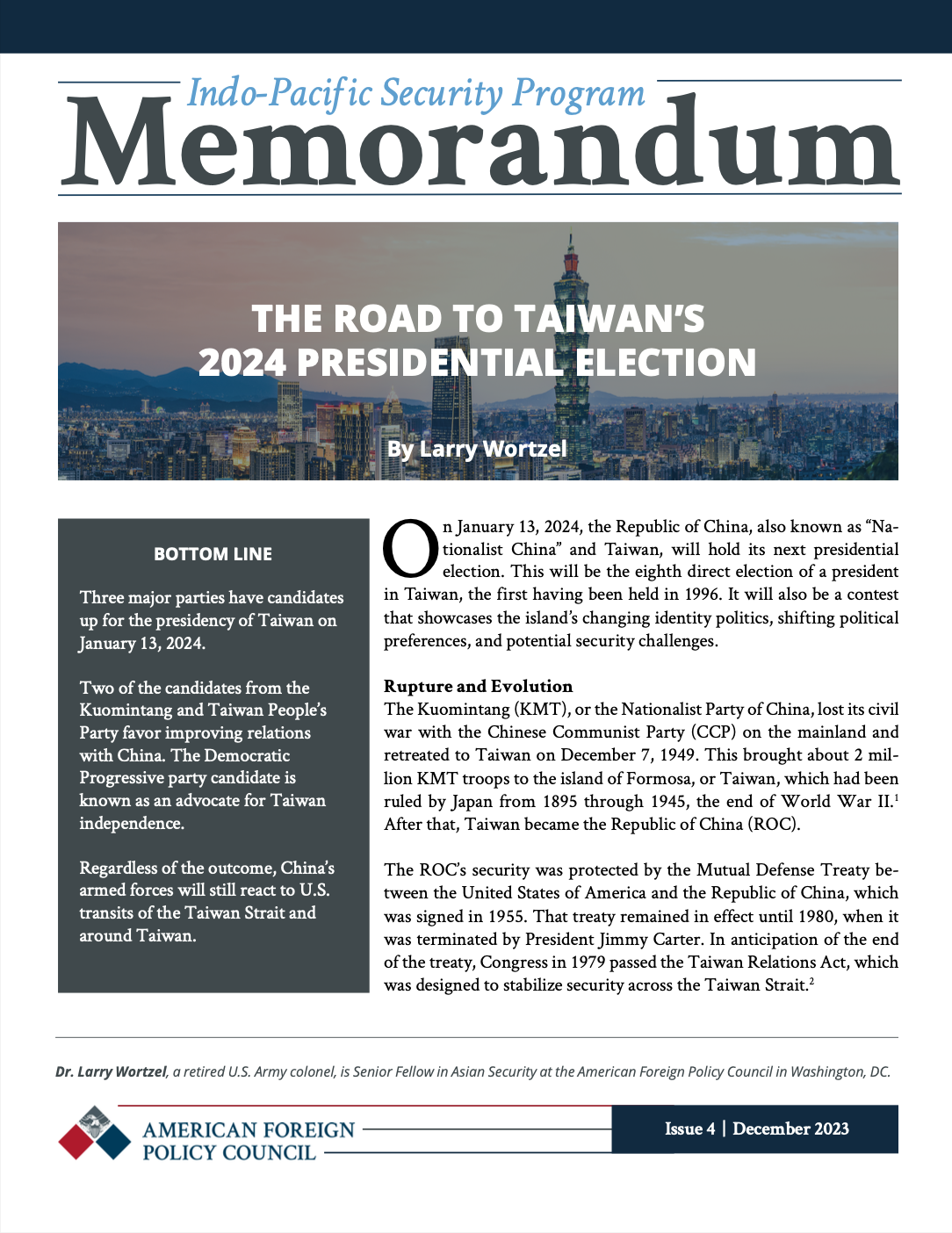
On January 13, 2024, the Republic of China, also known as “Nationalist China” and Taiwan, will hold its next presidential election. This will be the eighth direct election of a president in Taiwan, the first having been held in 1996. It will also be a contest that showcases the island’s changing identity politics, shifting political preferences, and potential security challenges.

For Israel, the Islamic Republic of Iran represents both a cardinal security challenge and an existential danger. The country’s current clerical regime is estimated to be connected to some “80 percent” of the contemporary security problems confronting the Jewish state.[1] These include not only Iran’s increasingly mature nuclear program, but also its extensive sponsorship of extremist proxies throughout the Mideast, as well as the radical expansionist ideology that continues to animate the regime in Tehran.
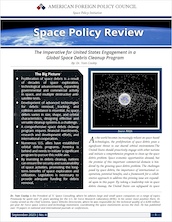
The United States should proactively engage with other nations and initiate a comprehensive program to clean up the space debris problem.
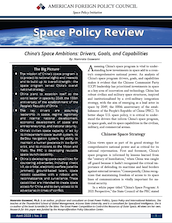
Assessing China’s space program is vital to understanding how investments in space add to a country’s comprehensive national power.
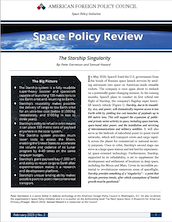
Starship, due to its reusability, size, and power, will dramatically improve access to low Earth orbit that will greatly support the expansion of public-and private-sector activity in space.
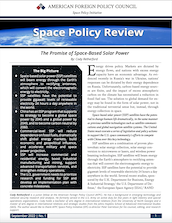
Commercial-level Space-based solar power (SSP) satellites will reduce dependence on fossil fuels, dramatically shift global energy markets, build economic and geopolitical influence, and accelerate military and space power projection.
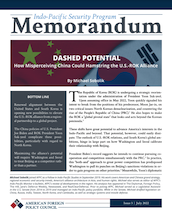
Renewed alignment between America and South Korea is opening new possibilities to elevate the U.S.-ROK alliance from a regional partnership to a global project. However, the China policies of Washington and Seoul are complicating these possibilities.

Since 2005, Congress has recognized that an asteroid impact represents a serious threat to national security. Though Congress tasked NASA to survey hazardous asteroids larger than 140m by 2020, sixteen years later it remains incomplete.
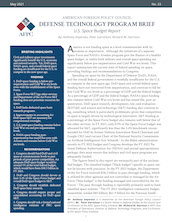
Civil and military space investments significantly benefit the U.S. economy and national security. Yet, DoD space, NASA space, and overall federal space funding are insufficient for the U.S. to compete in the new space age.
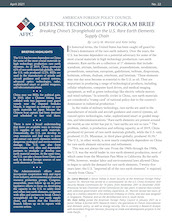
The U.S. has become dependent on a potential adversary for some of the most crucial materials in high technology production: rare earth elements.
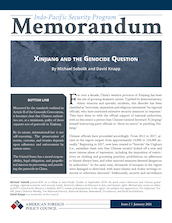
Measured by the standards outlined in Article II of the Genocide Convention, it becomes clear that Chinese authorities are, at a minimum, guilty of three separate acts of genocide in Xinjiang.
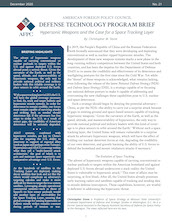
Given the curvature of the Earth, as well as the speed, altitude, and maneuverability of hypersonics, the only way to provide coverage is to place sensors in orbit around the Earth.
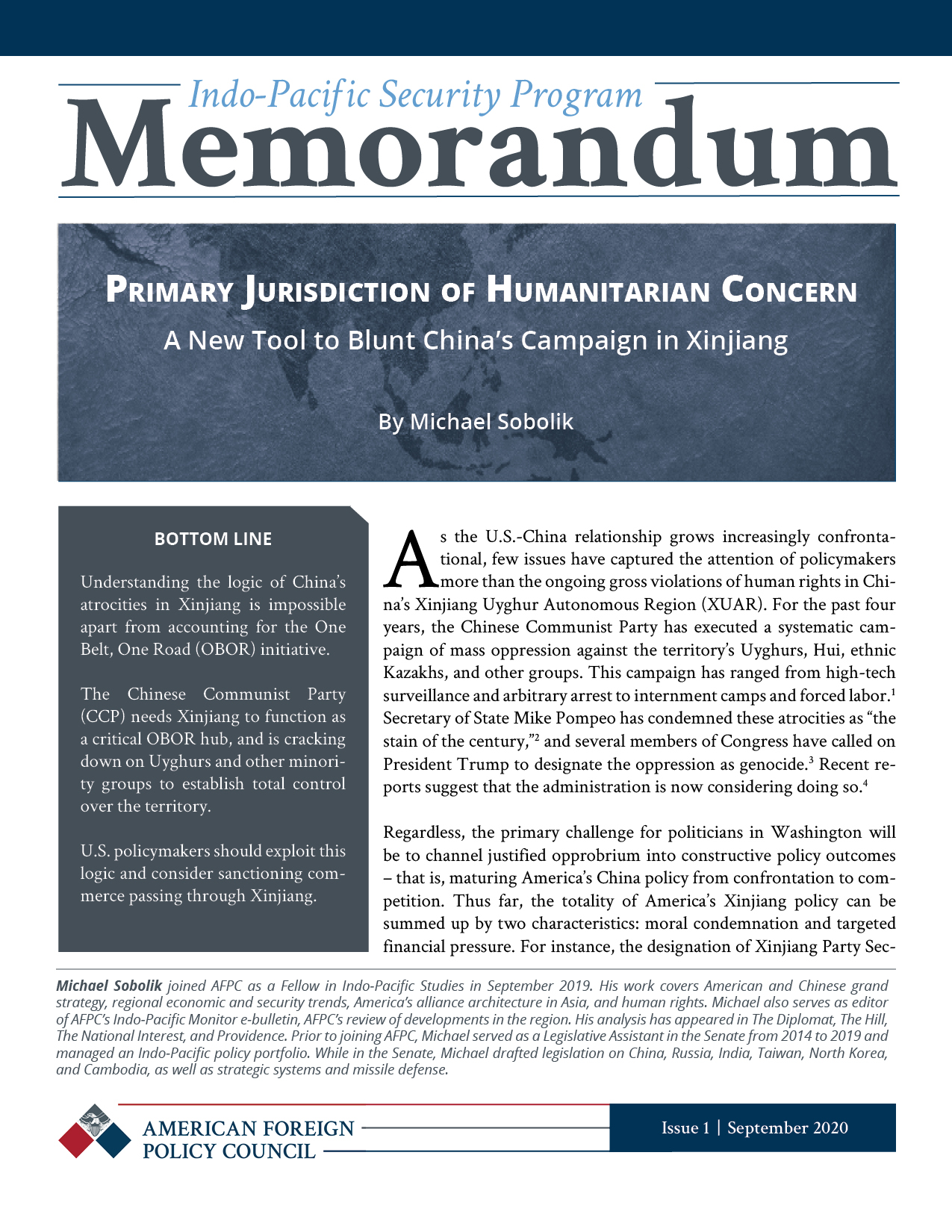
Understanding the logic of China’s atrocities in Xinjiang is impossible apart from accounting for the One Belt, One Road (OBOR) initiative. The Chinese Communist Party (CCP) needs Xinjiang to function as a critical OBOR hub, and is cracking down on Uyghurs and other minority groups to establish total control over the territory. U.S. policymakers should exploit this logic and consider sanctioning commerce passing through Xinjiang.
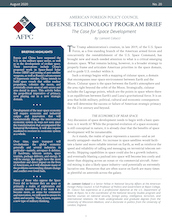
Any discussion of space development needs to begin with a basic question: is it worth it?
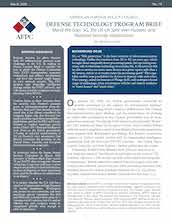
Britain’s decision to allow Huawei built 5G infrastructure presents acute challenges to the U.S.
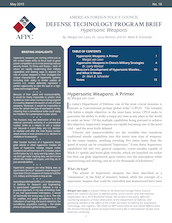
Hypersonic weapons are coming online just as the United States shifts its focus back to great power competition as its most pressing national security threat.

In the Spring of 2017, the management of the Broadcasting Board of Governors (BBG), the U.S. government’s official coordinating body for international media, approached the American Foreign Policy Council with a request. In response to persistent criticism from lawmakers on Capitol Hill, as well as mounting pressure from the newly-inaugurated Trump administration, the agency sought to commission an independent review of the content of its Persian-language media outreach. Such a process, BBG professionals explained, would help the agency to identify and rectify significant deficiencies at a time when the role of U.S. broadcasting toward the Islamic Republic was a topic of growing scrutiny (and skepticism) among those formulating the country’s strategy toward Iran...
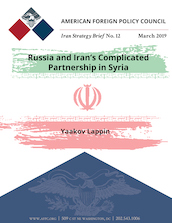
In 2015, Russia formally entered the Syrian conflict, becoming the Assad regime’s second sponsor, alongside Iran. The grounds for that intervention, we now know, were laid at a 2015 meeting between Russia’s Foreign Minister, Sergey Lavrov, and Iranian Supreme Leader Ayatollah Khamenei.
As Central Asians seek to design structures of cooperation that fit their needs, they should certainly build on the achievements of the late 1990s.
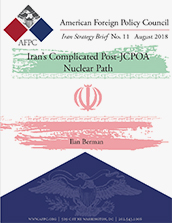
In the aftermath of President Donald Trump’s May 8th decision to formally end America’s participation in the 2015 nuclear deal known as the Joint Comprehensive Plan of Action (JCPOA), there has been significant speculation about potential responses on the part of the Iranian leadership.
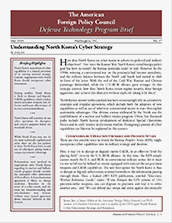
How does North Korea use cyber means to achieve its political and military objectives? Ever since the Korean War, North Korea’s stated foreign policy goal has been to reunify the Korean peninsula under its rule.
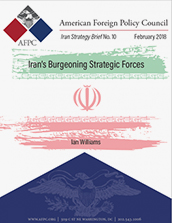
Among the Islamic Republic of Iran’s central strategic goals are the preservation of its political regime and its ascension to what it views as its rightful place as the regional hegemon of the Middle East.
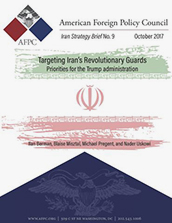
The passage this summer of the Countering America’s Adversaries Through Sanctions Act, a wide-ranging legislative package that imposed new economic pressure on Russia, Iran and North Korea, reignited the debate over U.S. policy toward the Islamic Republic.
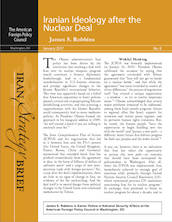
The Obama administration’s Iran policy has been driven by the conviction that reaching a deal with Iran over its nuclear weapons program would constitute a historic diplomatic breakthrough, lead to a fundamental transformation in U.S.-Iranian relations, and prompt significant changes in the Islamic Republic’s international behavior.
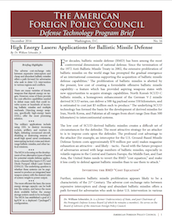
For decades, ballistic missile defense (BMD) has been among the most controversial dimensions of national defense.
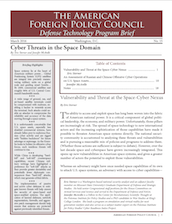
The ability to access and exploit space has long been woven into the fabric of American national power. It is a critical component of global political leadership, the economy, and military power. Unfortunately, those pillars are increasingly at risk. The spread of space technology to new international actors and the increasing sophistication of those capabilities have made it possible to threaten American space systems directly. The national security community is accustomed to analyzing these threats and vulnerabilities and is pursuing a reasonable mix of policies and programs to address them. (Whether those actions are sufficient is subject to debate). However, over the last decade space and cyberspace have grown increasingly integrated. This opens up new vulnerabilities in American space systems, and gives a greater number of actors the potential to exploit those vulnerabilities...

What is the role of cybersecurity in the conduct of war and ongoing security operations? Policymakers, academics, and journalists often think of cybersecurity as a single domain problem. That is to say, they view cyber operations as taking place solely within its own domain—one that is separate from land, sea, air or space. This perspective, however, overlooks the fact that computer systems and networks pervade society and the physical environment, and are present to some degree in all physical environs and across the three levels of war (strategic, operational, and tactical). Modern militaries employ forces in a “joint” manner, combining the specific platforms and technologies of different services to achieve a more effective force. National security policymakers should similarly see both kinetic and cyber capabilities as part of a broad set of tools available to achieve their objectives. Thinking of cybersecurity as a limited or separate space, wholly distinct from the other domains of conflict, limits the potential for understanding its strategic utility...
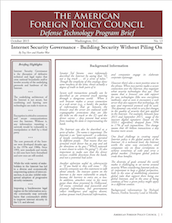
Internet Security Governance covers the policy challenges that arise from building and governing security in the Internet’s architecture and key protocols. It is not a description of security for computers and networks (Information Assurance), how to manage the negotiated structure and key functions of the Internet (Internet Governance), or the pursuit of criminal groups and other threat actors (Cyber Crime). Internet Security Governance is the discussion of defensively oriented technical and legal topics that cross national boundaries and/or involve security of the underlying protocols and hardware which make up the Internet...
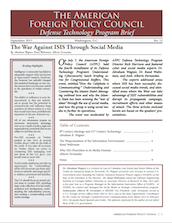
On July 7, the American Foreign Policy Council (AFPC) held the fourth installment of its Defense Technology Program’s Understanding Cybersecurity lunch briefing series for Congressional Staffers. This event, entitled, “How the Caliphate is Communicating:” Understanding and Countering the Islamic State’s Messaging outlined how and why the Islamic State has been winning the “war of ideas” through the use of social media, and how the group is using social media to further its operations...
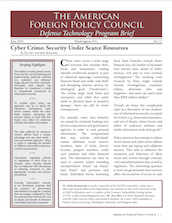
Cyber crime covers a wide range of activities that includes theft, fraud and harassment; stealing valuable intellectual property as part of industrial espionage; committing financial fraud and credit card theft; and disrupting internet services for ideological goals (“hacktivism”). The crimes target both firms and consumers, and while they rarely result in physical harm or property damage, there can still be severe consequences...
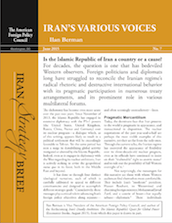
Is the Islamic Republic of Iran a country or a cause? For decades, the question is one that has bedeviled Western observers. Foreign politicians and diplomats long have struggled to reconcile the Iranian regime’s radical rhetoric and destructive international behavior with its pragmatic participation in numerous treaty arrangements, and its prominent role in various multilateral forums.
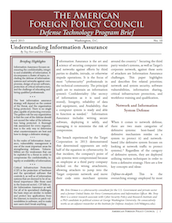
Information Assurance is the art and science of securing computer systems and networks against efforts by third parties to disable, intrude, or otherwise impede operations. It is the focus of most “cybersecurity” professionals in the technical community. The principal goals are to maintain an information system’s Confidentiality (the secrecy of information as it is used and stored), Integrity, reliability of data and equipment, and Availability, that a computer system is ready and able to function as needed. Information Assurance includes writing secure software, deploying it safely, and managing it to minimize the risk of compromise.